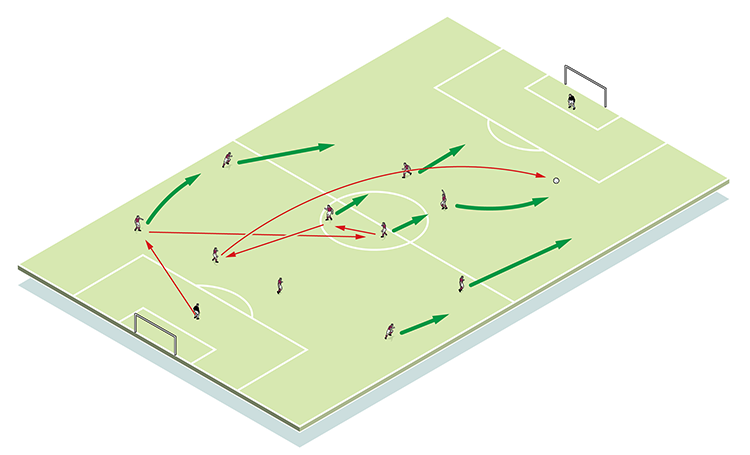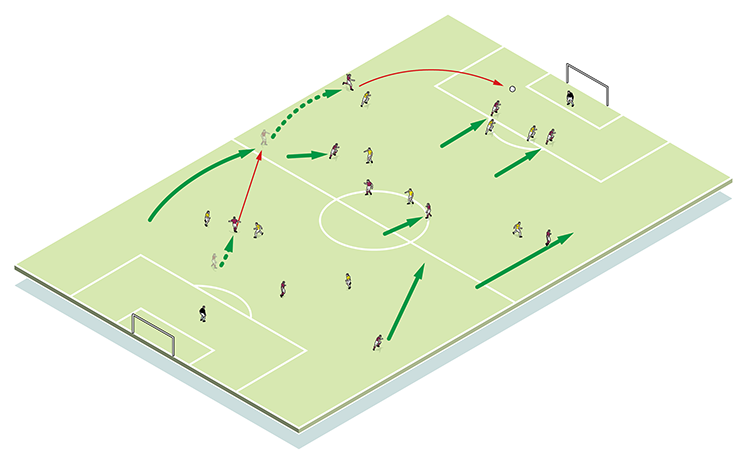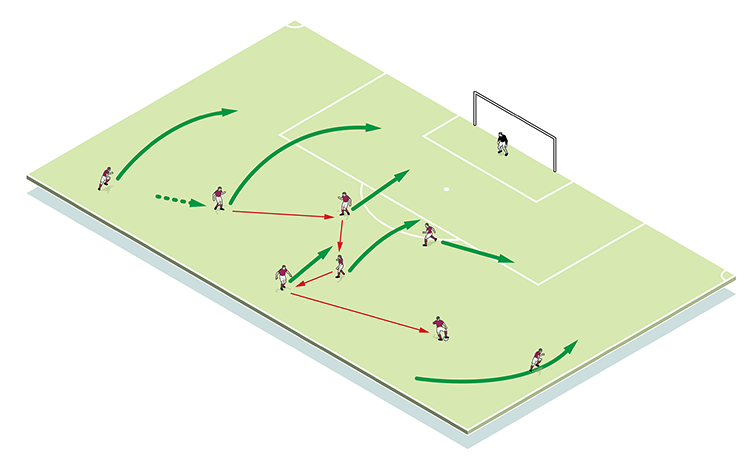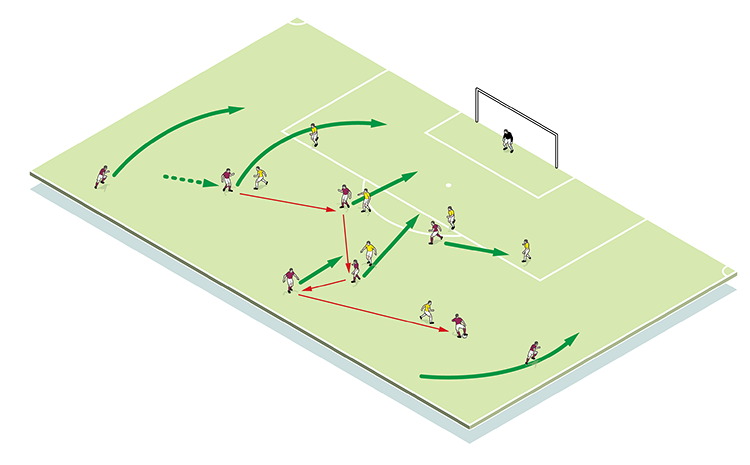You are viewing 1 of your 1 free articles
Diagonal passing
| Area | Full pitch |
| Equipment | Balls, cones, goals |
| No. of Players | Up to 22 |
| Session Time | 3x15mins per practice, with rotations and reviews |
This session is about changing the direction of play, including in counter-attacking, in order to create space, and to spread the opposition’s shape.
It’s based on the idea of a decisive diagonal pass and the subsequent movement to receive and support.
Starting in defence, the principles are then used in gaining space and advantage in attacking overload situations, thus looking to create an end product, be that a cross, pass or a finish.
It’s important to practise this from both offensive and defensive perspectives. A team might be pressing with little space to receive, so to turn them puts us on the front foot. Similarly, defending deep and being well organised means there should be little space for opposition attackers to thread through two banks of defenders.
What do I get the players to do?
Moving out of defence
Setting up as shown, we work players through the key components of the practice, ensuring that the movement out of defence is characterised by precise, quick and decisive diagonal passing.
It begins with full-back movement in order to receive from the keeper. The left-back then plays into midfield. Centre-midfielders receive and interlink, then set the ball back to one of the centre-backs, who has space and time on the ball.
The centre-back now has a choice – he can either play diagonally into space on the wings, or directly upfield to the centre-forward who has made room for himself (1).
1

We would begin this practice unopposed, before bringing in opposition players (2).
2

What are the key things to look out for?
Good interlink play will always force opponents to move forward and lose their shape, and that’s a key aim in these practices. We also want to see support runs from all other players in making themselves available (3), a good choice of passes, and pass appreciation. And it’s key that players frequently adjust their positions, staying on the front foot in order to maximise potential attacking opportunities.
3

Attacking aims
The next part of the practice examines play in the final third, with players switching play to create space and overloads. They do this by interlinking, passing quickly (4), and forcing the defending team to stay narrow for as long as possible.
4

Again, we would begin this unopposed, before bringing in opposition players.
What are the key things to look out for?
We want to see smart movement to receive and quick movement to support, with the intention of creating overloads wherever possible. And of course, it’s vital there’s a positive end product, be that a pass, a shot or a cross (5), with offensive players making determined runs into the box to cover vital crossing areas (6).
5

6

Related Files
Editor's Picks
Deep runs in the final third
Using the goalkeeper in build-up play
Pressing principles
Intensive boxes drill with goals
Penetrating the final third
Creating and finishing
My philosophy
Pressing initiation
Compact team movement
Coaches' Testimonials

Alan Pardew

Arsène Wenger

Brendan Rodgers

Carlos Carvalhal

José Mourinho

Jürgen Klopp

Pep Guardiola

Roy Hodgson

Sir Alex Ferguson

Steven Gerrard
Coaches' Testimonials

Gerald Kearney, Downtown Las Vegas Soccer Club

Paul Butler, Florida, USA

Rick Shields, Springboro, USA

Tony Green, Pierrefonds Titans, Quebec, Canada
Join the world's leading coaches and managers and discover for yourself one of the best kept secrets in coaching. No other training tool on the planet is written or read by the calibre of names you’ll find in Elite Soccer.
In a recent survey 92% of subscribers said Elite Soccer makes them more confident, 89% said it makes them a more effective coach and 91% said it makes them more inspired.
Get Monthly Inspiration
All the latest techniques and approaches
Since 2010 Elite Soccer has given subscribers exclusive insight into the training ground practices of the world’s best coaches. Published in partnership with the League Managers Association we have unparalleled access to the leading lights in the English leagues, as well as a host of international managers.
Elite Soccer exclusively features sessions written by the coaches themselves. There are no observed sessions and no sessions “in the style of”, just first-hand advice delivered direct to you from the coach.









